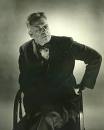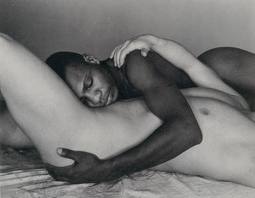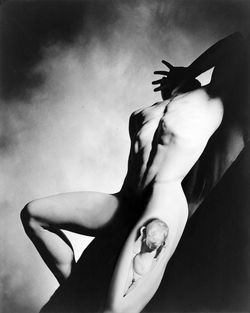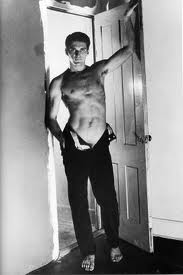|
|
||
|
Pro Tools
FILMFESTIVALS | 24/7 world wide coverageWelcome ! Enjoy the best of both worlds: Film & Festival News, exploring the best of the film festivals community. Launched in 1995, relentlessly connecting films to festivals, documenting and promoting festivals worldwide. Working on an upgrade soon. For collaboration, editorial contributions, or publicity, please send us an email here. User login |
George Platt Lynes: Idolizing The Male BodySince the first recorded images to the pantheons of Greece and Rome to the contemporary art world's fascination with the human form, the human body has not only been a source of inspiration but also of expression for artists in all medium. The sculptures that we still admire from ancient times are just the starting point for a continued obsession with the perfection of the human musculature. That obsession was certainly the key note in the artistic development and output of photographer George Platt Lynes, as evidenced by a superb new book from publisher Rizzoli USA entitled GEORGE PLATT LYNES: THE MALE NUDES. Lynes, a demi-monde fashion and celebrities photographer of the 1930s, 1940s and 1950s, had a secret passion during his short but blazing career. From his early twenties until his untimely death at the age of 47 in 1955, Lynes created a remarkable canon of male nudes, using the dramatic techniques he had adopted for the celebrity portraiture to reveal the beauty and drama of the male form. The subjects of his nude portraiture ranged from professional models and dancers to sailors, workers and “ordinary” men who caught his eye and his interest (including a 1942 photograph of a beefy Yul Brynner, long before he became the King of Siam in Broadway and Hollywood versions of THE KING AND I). As a very public gay man in a very closeted time, his interest in beautifully coiffed, finely turned out (and generally well hung) men was in keeping with his own private obsessions and idealization of beauty. As illustrated in the excellent accompanying text by Steven Haas, many of the models would become private lovers of the photographer whose appetite for beauty, luxury and sensuality became legion. Lynes was a beautiful creature in his own right, with a lithe sensual frame, handsome face and a prematurely gray mane of hair that became his signature. Haas, the director of the George Platt Lynes Foundation and himself a noted photographer and art historian, knows his subject quite intimately. He charts the course of Lynes’ life as the coddled son of a New Jersey parish rector through his journeys in Paris, New York, Los Angeles and Rome, portraying the glamour of an aesthetic adventurer who rubbed shoulders with such luminaries as Gertrude Stein, Jean Cocteau, Andre Gide, Marcel Duchamp, Man Ray, Pavel Tchelitschew, Christopher Isherwood, Paul Cadmus, Lincoln Kirstein, Alfred Barr and various Hollywood movie stars (all of whom he also photographed, many repeatedly). With ambitions to become a novelist, the 18 year old Lynes made his first trip to Paris in 1927 and become caught up in the salon circle of Gertrude Stein and her entourage of writers, painters, sculptors, heiresses and other opinion makers. Lynes was to live in Paris on and off over the years, clearly identifying with the city’s passion for the arts and its bohemian sub-culture. He never quite got to write his novel (too much partying?) but his photographs of local celebrities and beautiful bohemians began to get noticed and he had his first photography exhibition in Paris. However, since he did not share the trust fund baby status of many of the American expats in Europe, Lynes had to sing for his supper, so as his photography career took off, the decision was made to base himself in New York, where he became a house photographer at such stellar publications as Vanity Fair, Vogue and Harper’s Bazaar. He firmly ensconced himself in the center of New York’s café society, using his lavish Upper East Side apartment as a salon that rivaled the one he first encountered years before in the modest Left Bank apartment shared by Gertrude Stein and Alice B. Toklas. Lynes, rather a dandy in his own right, was renowned for over-the-top parties and lavish dinners, often given at times when he was personally scrounging for cash and his next lucrative photo shoot.
In his essay, Haas makes the point that Lynes often lived way beyond his means, relying on the patronage of the well-heeled throngs who orbited his own blazing sun to pick up the check. In New York, he lived in a series of apartments, ranging from fashionable Upper East Side boites to cold water flats in the city’s then unfashionable Hell’s Kitchen district in the way West Side. However, no matter where he called home, Lynes’ penchant for extravagant living never let up. A brief sojourn to Hollywood in the 1940s produced some fascinating celebrity shoots (and some private ones of sailors returning from the Pacific theater of war) but Lynes’ personal aesthetic and out-there sexuality did not gel with the company town’s often puritanical morality. While fashion and ballet photos and celebrity portraits of such icons as Orson Welles, Diana Vreeland and Salvador Dali paid the bills, Lynes apparently felt most alive when he was able to lure beautiful young men to his New York photography studio for private shoots that, in the fashion of the time, were modeled on a kind of “classical eroticism” reminiscent of the Greek and Roman statues that fired his imagination on his first trips to Europe. These photo shoots also illustrated Lynes' affinity with the surrealism art movement that deeply impressed him. The nude photos did generate some money in very hush-hush sales to American and European patrons, but mainly they were answering to the aesthetic and erotic interests of Lynes himself. As he is quoted in the current volume’s opening page: “I’ve always done my best work when I’ve worked only for pleasure, when I’ve not been paid, when I’ve had a completely free hand, when I’ve had a model who excited me in one way or another.” Aside from the comprehensive story of Lynes’ brief but glittering life and a short but moving testimonial to his uncle by his nephew George P. Lynes II, most of this handsome tome is devoted to full page plates of the male nude photos themselves. Most are in the classical mode, with dramatic lighting caressing the shapely torsos and giving dramatic allure to the visage of his subjects. A few are more explicitly erotic, showing male couplings in suggestive poses and more than a few with full erections on display. These certainly were photos that were only shown to a few intimates or exchanged (for cash or sexual favors) with well-heeled clients in the US and abroad. A rather curious but fascinating part of the Lynes’ legend is his relationship with the pioneering sexologist Alfred Kinsey. Beginning in 1949, when Kinsey had published his legendary The Kinsey Report on modern sexuality, Lynes began an intense friendship with Kinsey, eventually entrusting him with the bulk of his negatives of the nude photographs he had been taking since the late 1920s. The photographs became an essential archive of the photographer’s most personal work and form the basis of GEORGE PLATT LYNES: THE MALE NUDES, a joint presentation of The Kinsey Institute and the artist’s estate. The over 200 magnificent photos included are printed with the deep sensuality and visual splendor that characterizes Lynes’ alertness and appreciation of the sculptural qualities of the male body.
As Allen Ellenzweig, a noted photography critic and the author of The Homoerotic Photograph, observes in the book’s Afterword, “He was a passionate lover of beautiful young men as if he willed a private Utopia into being. Twentieth century photography is the richer for it; we are his beneficiaries.” For more information, visit: http://www.rizzoliusa.com/search.php?title_subtitle_auth_isbn=george+platt+lynes
Sandy Mandelberger, The Printed Page Editor 05.05.2011 | The Printed Page's blog Cat. : Alfred Barr Alfred Kinsey Alice B. Toklas Allen Ellenzweig André Gide Artist Arts Christopher Isherwood Contact Details critic and the author DIANA VREELAND Director editor Entertainment Entertainment Europe Family Relation Fashion photographers George P. Lynes II George Platt Lynes George Platt Lynes George Platt Lynes Gertrude Stein Harper historian http://www.rizzoliusa.com/search.php?title_subtitle_auth_isbn=george+platt+lynes Human Interest Human Interest Jean Cocteau King Lincoln Kirstein Lincoln Kirstein Los Angeles Marcel Duchamp New Jersey New York New York New York’s café novelist Orson Welles Paris Paul Cadmus Pavel Tchelitschew Person Attributes Person Career Person Travel Photographer Photography Private Rector Religion Religion Rome Salvador Sandy Mandelberger Social Issues Social Issues Steven Haas Technology Technology the king The Printed Page Vanity Fair Visual arts Yul Brynner PEOPLE
|
LinksThe Bulletin Board > The Bulletin Board Blog Following News Interview with IFTA Chairman (AFM)
Interview with Cannes Marche du Film Director
Filmfestivals.com dailies live coverage from > Live from India
Useful links for the indies: > Big files transfer
+ SUBSCRIBE to the weekly Newsletter Deals+ Special offers and discounts from filmfestivals.com Selected fun offers
> Bonus Casino
User imagesAbout The Printed PageThe Editor |





























